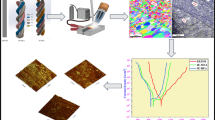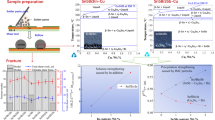The possibility of partial or complete replacement of PbO in fusible glass solders by less toxic components is investigated. It is found that it is impossible to find a full-fledged replacement for glasses in the lead-borate eutectic, used as the glass base in glass soldering compositions for sealing glass ceramic packages of integrated microcircuits at temperatures 390 – 420°C, within the systems PbO – P2O5– ZnO – B2O3,V2O5– P2O5– ZnO – B2O3, and TeO2– PbO – V2O5– Bi2O3 with different additives and total mass content of class-I hazard components not exceeding 70%.
Similar content being viewed by others
References
I. W. Donald, “Preparation and chemistry of glass and glass ceramic- to-metal seals and coatings,” Mater. Sci., 28, 2871 – 2886 (1993).
D. A. Geodakyan, B. V. Petrosyan, and K. D. Geodakyan, “Design and synthesis of fusible glass solders with prescribed properties,” Steklo Keram., No. 9, 27 – 33 (2007); D. A. Geodakyan, B. V. Petrosyan, and K. D. Geodakyan, “Design and synthesis offusible glass solders with previously assigned properties,” Glass Ceram., 64(9 – 10), 326 – 332 (2007).
D. A. Geodakyan, B. V. Petrosyan, and K. D. Geodakyan, “Low melting lead-containing glasses,” Izv. Nats. Akad. Nauk Armenii, 3, 441 – 447 (2007).
V. Yu. Vasil’ev, “Thin layers of borophosphorosilicate glass in silicon microelectronics technology. Part 1. Deposition from the gas phase and properties of glass layers,” Mikroelektronika, 33(5), 334 – 351 (2004).
V. Yu. Vasil’ev, “Thin layers of borophosphorosilicate glass in silicon microelectronics technology. Part 2. Structure of glassesand their application in technology,” Mikroelektronika, 34(2), 83 – 97 (2005).
V. Dima, P. Balta, M. Eftimie, and V. Ispas, “Low melting glasses in the system SnF2– SnCl2– PbO – P2O5 ,” Optoelectron. Advanced Mater., 8(6), 2126 – 2128 (2006).
V. G. Dzhavadyan, M. Yu. Abovyan, D. A. Geodakyan, and R. M. Oganesyan, “Glasses and glass compositions for passivating and sealing of semiconductor devices,” Vestn. Stroitelei Armenii, No. 2, 23 – 25 (2001).
Author information
Authors and Affiliations
Corresponding author
Additional information
Translated from Steklo i Keramika, No. 11, pp. 15 – 18, November, 2009.
Rights and permissions
About this article
Cite this article
Geodakyan, D.A., Petrosyan, B.V., Stepanyan, S.V. et al. Investigation of the possibility of replacing high-lead glasses in fusible glass solders by less toxic glasses. Glass Ceram 66, 381–384 (2009). https://doi.org/10.1007/s10717-010-9206-7
Published:
Issue Date:
DOI: https://doi.org/10.1007/s10717-010-9206-7




